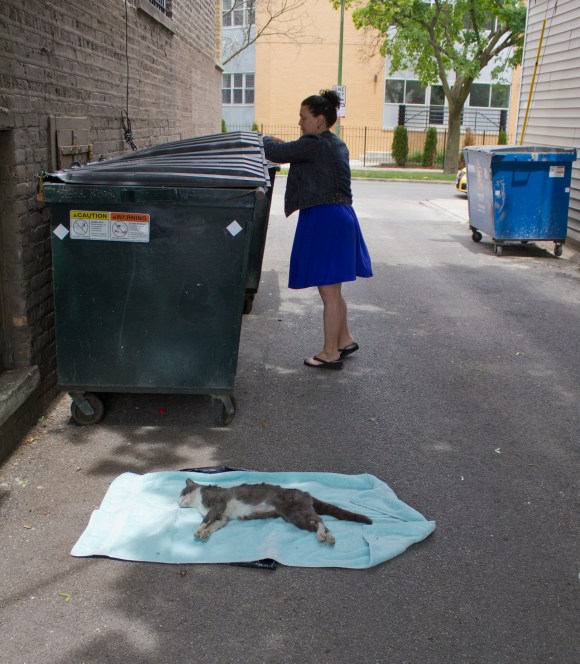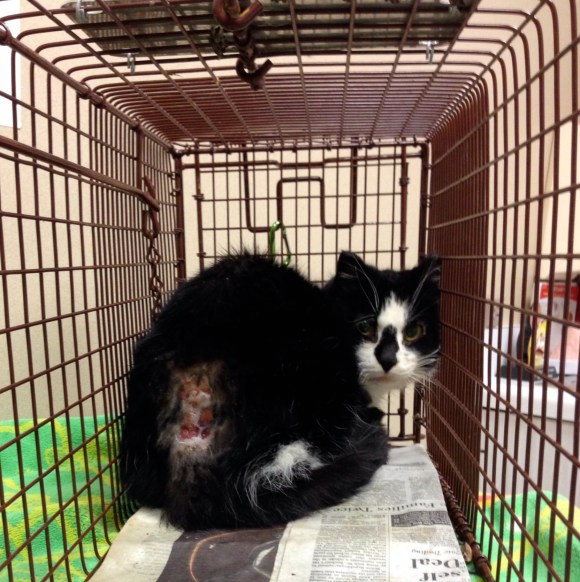RIP Ivan, Colony Cat from Avondale
Ivan is the second cat that has died since we started the Avondale TNR Project. With every TNR project of this size – here we are talking about estimates of 50 cats within three blocks – there are always inevitably sad endings along with the happy ones.
Ivan was trapped and taken to the clinic on May 31st for his TNR treatment. He was feral and his surgery went without a hitch. He was returned back outside to the colony after recovery without a problem, along with a few other TNR’d adult feral cats. They are all healthy, even tested FIV-/FeLV-, and have lots of feeders and garages for shelter.

The next photos may be upsetting to people, so consider this a warning.
Last weekend Joann got a call from George, the feeder who is trying to stop us from trapping, to say he found a dead cat in the alley. He was furious, and most likely blames us for killing this cat. He also texted Erica from PAWS this photo of Ivan’s dead body, without an explanation. Can you imagine?
 George also then called Erica and screamed at her for twenty minutes about us and the cats. She has been trying to help him for the past few years now with TNR. We wish we could get him to listen to us, but at this point there is no time or reasoning with him. We want to concentrate on helping the cats as much as possible with the time we have. The only good thing is that at least he called to tell us. Even when the outcome is tragic, it is better to know what happened, rather than just having a cat disappear. When Joann talked to George and other residents, they said someone already threw out his body. Joann and Kim searched the alley and found his body in this dumpster, right near where we’ve been trapping this past month.
George also then called Erica and screamed at her for twenty minutes about us and the cats. She has been trying to help him for the past few years now with TNR. We wish we could get him to listen to us, but at this point there is no time or reasoning with him. We want to concentrate on helping the cats as much as possible with the time we have. The only good thing is that at least he called to tell us. Even when the outcome is tragic, it is better to know what happened, rather than just having a cat disappear. When Joann talked to George and other residents, they said someone already threw out his body. Joann and Kim searched the alley and found his body in this dumpster, right near where we’ve been trapping this past month.


This is not the proper way to dispose of an animal’s dead body. Also, they wanted to make sure to scan him for a microchip so that we were absolutely sure that this was Ivan.
Joann took him to MedVet Chicago. They scanned him for his microchip, and examined him. They did not find any signs of trauma or broken bones. They found his mouth was clenched shut and full of blood. They thought he may have died of rat poisoning, but said they could not tell for sure without a necropsy, which costs $900 there. They then disposed of him free of charge. We are very grateful for their help and compassion in this matter.

Ivan also may have died from trauma from being hit by a car. I have found other cats like this, and so have other trappers. Cats get a glancing blow to the head or body, and then die a day or two later from internal bleeding. Yes, a necropsy is needed to know for sure.
RIP, Ivan. We wished we could’ve helped you sooner, but we know you are free of pain now. We will keep trying to help the rest of the cats in this area with TNR.






















